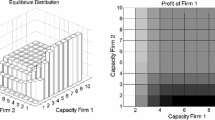Summary. In this paper, we analyze the interaction between an incumbent's financial contract with a bank and its product market decisions in the face of a threat of entry, in a dynamic model with asymmetric information. The main results of the paper are: there exists a separating equilibrium with no limit pricing; the low-cost incumbent repays more to the bank in the first period due to the threat of entry; and there are parameter values for which the bank makes more profits with the threat of entry than without.
Similar content being viewed by others
Author information
Authors and Affiliations
Additional information
Received: July 19, 2002; revised version: December 4, 2002
Correspondence to: N. Jain
Rights and permissions
About this article
Cite this article
Jain, N., Jeitschko, T. & Mirman, L. Financial intermediation and entry-deterrence. Econ Theory 22, 793–815 (2003). https://doi.org/10.1007/s00199-002-0351-2
Issue Date:
DOI: https://doi.org/10.1007/s00199-002-0351-2




